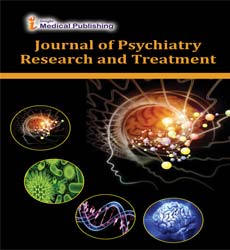Post-Traumatic Stress Disorder (PTSD): Neurocircuitry, Biomarkers, and Treatment Innovations
Müller Alicia*
Department of Psychiatry and Bio behavioral Sciences, University of California, Los Angeles, CA, USA
*Corresponding author:
Müller Alicia,
Department of Psychiatry and Bio behavioral Sciences, University of California, Los Angeles, CA, USA;
Email:müller@alicia.edu
Received date: January 01, 2025, Manuscript No. Ipprt-25-20616; Editor assigned date: January 03, 2025, PreQC No. Ipprt-25-20616(PQ); Reviewed date: January 15, 2025, QC No. Ipprt-25-20616; Revised date: January 22, 2025, Manuscript No. Ipprt-25-20616(R); Published date: January 28, 2025, DOI: 10.36648/ 2471-7975.7.1.03
Citation: Alicia M (2025) Post-Traumatic Stress Disorder (PTSD): Neurocircuitry, Biomarkers and Treatment Innovations. J Psychiatr Res Vol.07 No.1: 03
Introduction
Post-Traumatic Stress Disorder (PTSD) is a complex psychiatric condition that develops following exposure to traumatic events such as war, accidents, natural disasters, or interpersonal violence. It is characterized by persistent intrusive memories, hyperarousal, avoidance behaviors, and cognitive-emotional disturbances that impair daily functioning. Recent research in neuroscience and psychiatry has shifted focus toward understanding the neurocircuitry underlying PTSD, identifying biomarkers that aid in diagnosis and prognosis, and advancing innovative treatment strategies that go beyond conventional psychotherapy and pharmacotherapy. This integrative approach has opened new possibilities for precision medicine in PTSD management [1].
Description
The neurocircuitry of PTSD primarily involves dysregulation of the amygdala, hippocampus, and prefrontal cortex, which are central to fear processing, memory consolidation, and emotional regulation. Hyperactivity of the amygdala leads to heightened fear responses, while hypo-activity of the prefrontal cortex impairs top-down regulation of emotional reactivity. The hippocampus, which plays a role in contextual memory and fear extinction, often shows reduced volume and altered function in PTSD patients [2].
Functional neuroimaging studies consistently highlight disrupted connectivity between these regions, explaining the persistence of maladaptive fear responses and intrusive memories. Biomarkers have emerged as promising tools to enhance the diagnosis and treatment monitoring of PTSD. Neuroendocrine markers such as altered cortisol levels and dysregulation of the Hypothalamicâ??Pituitaryâ??Adrenal (HPA) axis have been frequently reported [3].
Genetic and epigenetic markers, including polymorphisms in stress-related genes like FKBP5, have been linked to individual vulnerability. Neuroimaging-based biomarkers, such as amygdala hyperreactivity or reduced hippocampal volume, offer objective insights into PTSD pathophysiology. Blood-based markers, including inflammatory cytokines and neurotrophic factors like BDNF, are also being explored to establish predictive profiles for disease progression and treatment responsiveness [4].
Treatment innovations for PTSD are increasingly focusing on integrating neurobiological insights with therapeutic interventions. Advances in neuromodulation techniques such as Transcranial Magnetic Stimulation (TMS) and Deep Brain Stimulation (DBS) show promise in targeting disrupted neural circuits. Pharmacological research has expanded to include novel agents such as ketamine, MDMA-assisted psychotherapy, and neurosteroids that modulate glutamatergic and neuroendocrine systems [5].
Conclusion
Post-traumatic stress disorder remains a significant public health concern due to its complex interplay of neurobiological, psychological, and environmental factors. Advances in understanding PTSD neurocircuitry and identifying reliable biomarkers have paved the way for innovative treatment approaches that move beyond traditional models. By combining neurobiological insights with precision psychiatry, digital health tools, and novel therapeutics, the future of PTSD care lies in personalized interventions that better address the heterogeneity of this disorder and improve long-term recovery.
Acknowledgment
None.
Conflict of Interest
None.
References
- Bear TLK, Dalziel JE, Coad J, Roy NC, Butts CA, Gopal PK (2020) The role of the gut microbiota in dietary interventions for depression and anxiety. Adv Nutr 11: 890–907
Google Scholar Cross Ref Indexed at
- Bueno-Notivol J, Gracia-García P, Olaya B, Lasheras I, López-Antón R, Santabárbara J (2021) Prevalence of depression during the COVID-19 outbreak: A meta-analysis of community-based studies. Int J Clin Health Psychol 21: 100196
Google Scholar Cross Ref Indexed at
- Dash S, Clarke G, Berk M, Jacka FN (2015) The gut microbiome and diet in psychiatry: Focus on depression. Curr Opin Psychiatry 28: 1–6
Google Scholar Cross Ref Indexed at
- Huang F, Wu X (2021) Brain neurotransmitter modulation by gut microbiota in anxiety and depression. Front Cell Dev Biol 9: 649103
Google Scholar Cross Ref Indexed at
- Kearns R (2024) Gut–brain axis and neuroinflammation: The role of gut permeability and the kynurenine pathway in neurological disorders. Cell Mol Neurobiol 44: 64
Open Access Journals
- Aquaculture & Veterinary Science
- Chemistry & Chemical Sciences
- Clinical Sciences
- Engineering
- General Science
- Genetics & Molecular Biology
- Health Care & Nursing
- Immunology & Microbiology
- Materials Science
- Mathematics & Physics
- Medical Sciences
- Neurology & Psychiatry
- Oncology & Cancer Science
- Pharmaceutical Sciences
